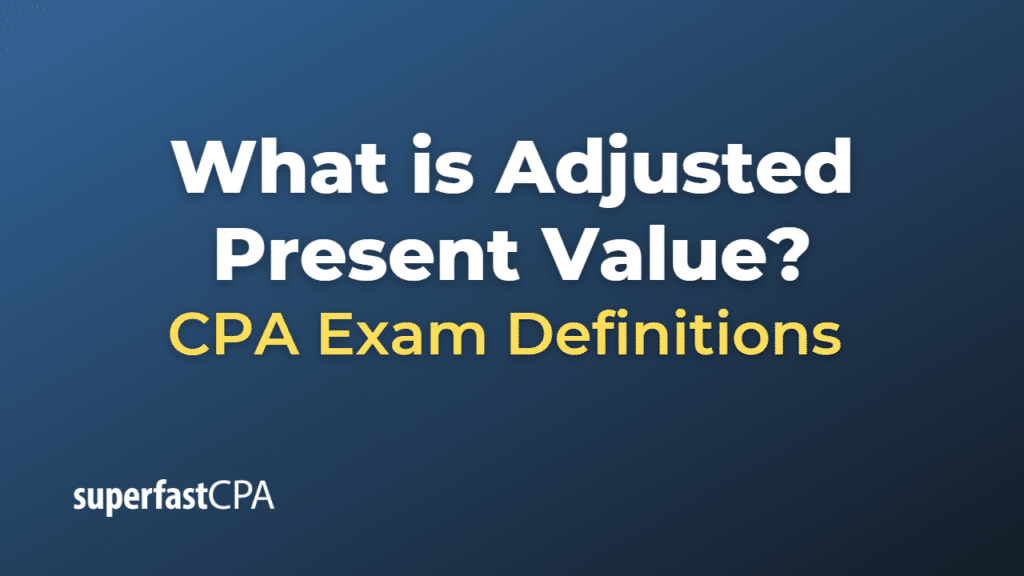Adjusted Present Value
Adjusted Present Value (APV) is a valuation method that separates the value of a project or a company into two components: the value of the project or company assuming it is financed entirely by equity, and the value of the financing side effects, such as tax shields from interest payments on debt. APV is particularly useful for evaluating projects with complex financing structures or varying levels of debt financing over time.
The APV calculation consists of the following steps:
- Calculate the present value of the project or company’s unlevered free cash flows, which represents the cash flows generated by the project or company as if it were financed entirely with equity. This is done by discounting the cash flows at the unlevered cost of equity (the required rate of return on equity if the company had no debt).
- Calculate the present value of the financing side effects, such as interest tax shields, by discounting them at the appropriate discount rate (often the cost of debt).
- Add the present values obtained in steps 1 and 2 to find the Adjusted Present Value of the project or company.
\(APV = NPV_{\text{unlevered}} + NPV_{\text{TS}} \)
Where:
- APV is the Adjusted Present Value.
- \(NPV_{unlevered} \) is the Net Present Value of the project or firm without leverage (i.e., as if it’s financed entirely with equity).
- \(NPV_{TS} \) is the Net Present Value of the tax shield, often due to the interest tax deductibility of debt.
The APV method is advantageous because it allows for a clear separation of the operating and financing decisions of a company and provides a more transparent view of a project or company’s value under different financing scenarios.
Example of Adjusted Present Value
Let’s consider a hypothetical company, XYZ Ltd., which is evaluating a new project. Here’s the relevant information:
- The project will generate $1,000,000 in annual free cash flows for the next 5 years.
- The project’s unlevered cost of equity is 10%.
- The company will finance the project with 60% equity and 40% debt.
- The interest rate on the debt is 6%, and the company has a 30% corporate tax rate.
We’ll use the Adjusted Present Value (APV) method to evaluate this project.
Step 1: Calculate the present value of the project’s unlevered free cash flows:
Year 1: $1,000,000 / (1 + 10%)^1 = $909,091
Year 2: $1,000,000 / (1 + 10%)^2 = $826,446
Year 3: $1,000,000 / (1 + 10%)^3 = $751,315
Year 4: $1,000,000 / (1 + 10%)^4 = $683,013
Year 5: $1,000,000 / (1 + 10%)^5 = $620,921
The total present value of the project’s unlevered free cash flows is $3,790,786.
Step 2: Calculate the present value of the financing side effects (interest tax shields):
The annual interest expense is 40% (debt portion) × $1,000,000 (annual cash flow) × 6% (interest rate) = $24,000. The annual interest tax shield is $24,000 × 30% (tax rate) = $7,200.
Now, we’ll calculate the present value of the interest tax shields over the 5-year period:
Year 1: $7,200 / (1 + 6%)^1 = $6,792
Year 2: $7,200 / (1 + 6%)^2 = $6,410
Year 3: $7,200 / (1 + 6%)^3 = $6,049
Year 4: $7,200 / (1 + 6%)^4 = $5,708
Year 5: $7,200 / (1 + 6%)^5 = $5,385
The total present value of the interest tax shields is $30,344.
Step 3: Calculate the Adjusted Present Value (APV):
\(APV = NPV_{\text{unlevered}} + NPV_{\text{TS}} \)
APV = $3,790,786 + $30,344 = $3,821,130
The Adjusted Present Value of the project is $3,821,130, which indicates the value of the project, taking into account both the cash flows generated by the project and the financing side effects.













